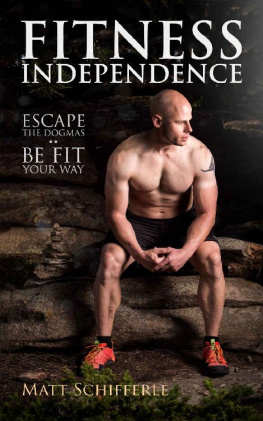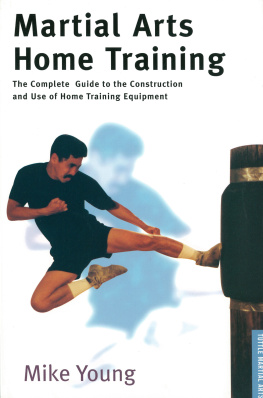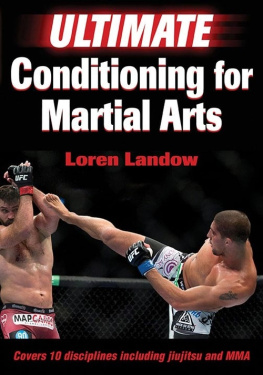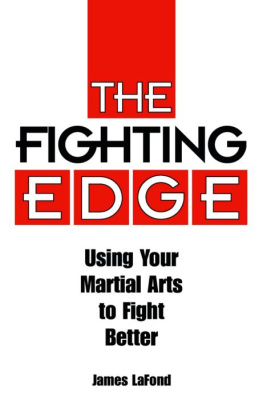Bodyweight Training for Martial Arts
By Matt Schifferle
Text Copyright 2019 Matthew J. Schifferle
All Rights Reserved
ISBN- 9781093665703
The information provided in this book is designed to provide helpful information on the subjects discussed. This book is not meant to be used, nor should it be used, to diagnose or treat any medical condition. For diagnosis or treatment of any medical problem, consult your own physician. The publisher and author are not responsible for any specific health or allergy needs that may require medical supervision and are not liable for any damages or negative consequences from any treatment, action, application or preparation, to any person reading or following the information in this book. References are provided for informational purposes only and do not constitute endorsement of any websites or other sources. Readers should be aware that the websites listed in this book may change.
Cover photo and design by Chris Clemens at http://www.thinkpilgrim.com
Dedicated to David Crowe,
and the high kicking students at Kojo Academy of Taekwon-Do.
Table of Contents
s
Introduction
Welcome to Bodyweight Training for Martial Arts! This book was written to teach you how to develop the physical qualities you need to perform at your best as a martial artist. Whether you're in MMA, Jiu-Jitsu, Karate or even Tai-Chi these holistic, and practical exercises, will take your training to the next level and beyond.
Who the heck am I?
My name is Matt Schifferle, and I've been a martial artist since age ten. Over the years, I've used a wide range of conditioning methods from classic bodybuilding programs to wearing weights while kicking. Everything worked to at least some degree, but all methods also came with a high price to pay. Some workouts took up so much time and energy that I had little left for my martial arts classes. Other approaches left me feeling slow and stiff. A few methods even threatened my entire martial arts career with muscle imbalances and injury. Everything always felt like one step forward and one step back.
The more I tried to get in top shape, the more frustrated I became. Martial arts were my gateway to physical training. It was how I learned the value of using a disciplined mind to transform my body. Now, here I was feeling like my gym workouts were putting my martial arts training in jeopardy.
After nearly 20 years of lifting iron, I was beat up, fed up and ready to give up. Not just on exercise, but even my Taekwon-Do. Thankfully, I started to learn about a discipline called progressive calisthenics, and my world changed forever. At long last, there was a training method that seemed to be all pros without any cons. Other approaches left me feeling used and abused, but calisthenics made me strong and resilient. As I write this, I've been practicing martial arts for 31 years and calisthenics for 10. Never before have I felt this strong, limber and explosive while also remaining free of stiffness and joint pain. I'm in better shape, and a better martial artist, now at age 41 than when I was in my 20s!
My story is not that unusual. Ive shared what Ive learned through my Red Delta Project and have heard from many whove had a similar experience. Men and women who once thought they were past their prime as martial artists have infused new life into their training with just a few simple calisthenics drills. Now, all of my ideas are in this single volume for you to enjoy and apply.
I attribute much of my success in life to the influence martial arts have had on my mind and body. Now it's my chance to pay it forward and present you with this book. The information within these pages can quite possibly enhance your martial arts training beyond anything you believe is possible. It may even save your training career. I know it certainly saved mine and for that, I'm ever thankful.
Keep kicking,
-Matt Schifferle
Chapter 1
The Advantages of Calisthenics for Martial Arts Conditioning
Bodyweight exercise and martial arts have been training partners ever since people learned how to throw a punch. Some of the oldest fighting styles have traditionally included calisthenics training as part of the regular training routine.
One of the best examples of this is the classic Shaolin training systems. When you observe the traditional styles, it's hard to draw a definitive line between calisthenics and martial arts. Legend has it the Shaolin fighting systems were developed from the calisthenics the monks were using to condition themselves for long hours of meditation.
An classic style practiced by a modern warrior shows how calisthenics and martial arts are one and the same. Photo: Ancient-origins.net
Such physical conditioning sure wasn't restricted to the far east. In Europe, physical conditioning was required training to become a formidable fighter from the Knights of medieval Europe to the wrestling styles of ancient Greece. Once again, training to fight and training to be athletically capable were considered the same. After all, how can someone be a proficient fighter if they can't skillfully use their body? At the same time, you could argue that someone wouldn't have a complete level of physical fitness if they couldn't fight and defend themselves.
The Movnat organization includes a variety of disciplines including climbing, running, crawling, swimming and basic martial arts techniques. Photo: Images from the Movnat promotional video on movant.com.
The 3 risks modern conditioning poses to your martial arts proficiency
Despite the long synergistic history of conditioning and martial arts training, the two disciplines have been practiced separately for the past few generations. Some experts have even criticized the idea of spending valuable energy at the gym instead of practicing kicks and sparring. Growing up, I remember being told to avoid strength training because it would make me tight and slow.
It's easy to scoff at an idea like that now, but its not entirely without merit. Strength training can pose several risks to your martial arts proficiency. One such risk is known as the interference effect when you spend so much effort in the gym that it starts to impede upon your martial arts training. I've seen this happen to several people who often boast about how hard they workout but later claim they feel sluggish and tired in the Dojo.
The second challenge is the risk of injury. Its a shame when lousy lifting technique or excessive loads hurt both your body and your martial arts practice. Sometimes, these injuries can be acute and happen suddenly, but most issues creep up over time and can take months to identify and resolve. Thats a long time to suffer through compromised martial arts training especially if youre preparing for a competition.
The last significant risk of inappropriate conditioning is the lack of functional carryover. In exercise physiology, there's something known as the S.A.I.D principle which stands for specific adaptation to imposed demand. In simple terms, it means that all exercises develop the unique physical qualities required by that very activity. This is why you'll never become a world-class hockey player even if you're an Olympic figure skater or an elite sprinter no matter how many marathons you complete. There is, however a degree of functional carryover where some of the functional abilities overlap. The figure skater may not have a good slap shot, but can probably learn how to skate like a hockey player pretty quickly since they are already comfortable on the ice.












